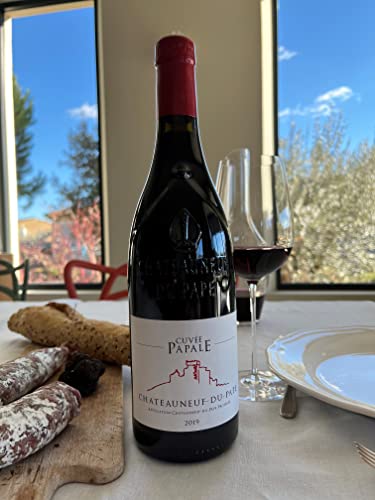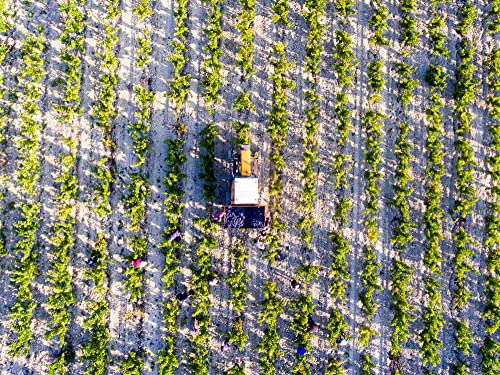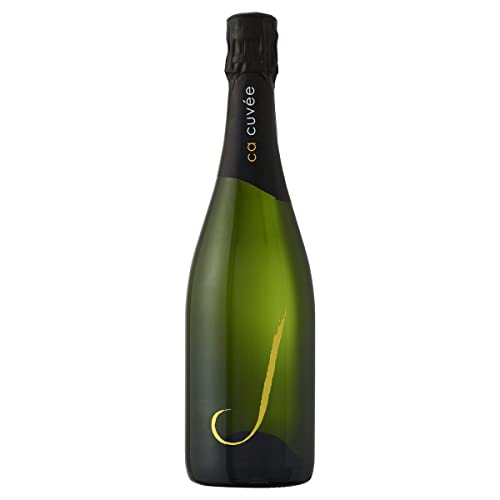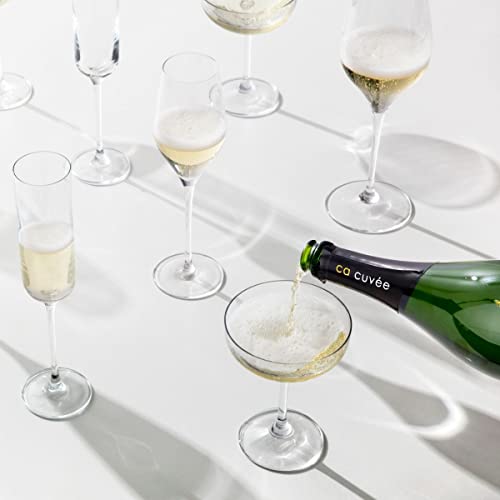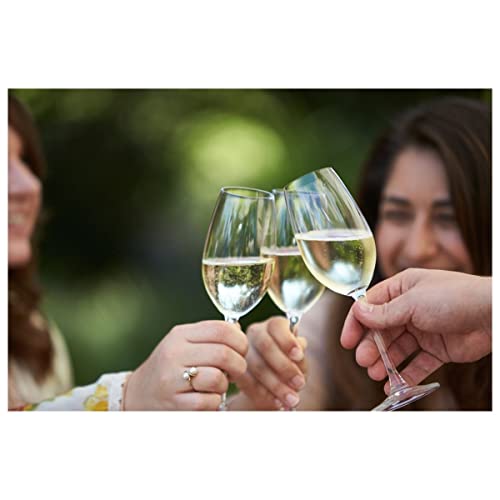Cuvee Wine Pairings: Perfect Matches For Every Occasion
Post Disclaimer
*We may earn a commission for purchases made using our links. Please see our disclosure to learn more.
Selecting the perfect wine for your special occasion can be challenging. Many wine enthusiasts find it difficult to choose the ideal match that complements their meal and enhances their dining experience. So. Cuvee Wine is here for you!
This challenge intensifies when considering cuvee wines, known for their unique blends and diverse flavor profiles.
Cuvee wines, derived from the French word for “vat” or “tank,” represent a special blend of grapes or wines. These carefully crafted combinations offer a wide range of flavors and aromas, making them versatile options for various food pairings.
Our guide will help you understand cuvee wine pairings, offering expert advice on selecting the best matches for different occasions and dishes. Prepare to impress your guests with your wine pairing skills.
Key Takeaways
- Cuvée wines are special blends that offer a wide range of flavors, making them versatile for food pairings.
- Sparkling cuvées pair well with light appetizers like bruschetta or oysters, while red cuvée blends complement steak and hearty pasta dishes.
- White and rosé cuvées should be served chilled at 45-50°F, while red cuvées are best at 60-65°F.
- The term “cuvée” comes from the French word for “vat” and originally referred to the first pressing of grape juice used in sparkling wines.
- When pairing cuvée wines with desserts, choose a wine that is sweeter than the dessert to avoid overpowering the wine’s flavors.
Understanding Cuvée Wine
Cuvée wine represents a unique blend of grapes or wines, crafted to achieve a specific flavor profile. This winemaking technique allows vintners to create complex and balanced wines that showcase the best qualities of different grape varieties or vintages.
What does \”cuvée\” mean in wine?
Cuvée” in wine terminology carries multiple meanings, often leading to confusion among enthusiasts. At its core, the term refers to a specific blend or batch of wine. This blend can encompass various elements, including different vineyards, vintages, or grape varieties.
Discover the elegance of Wander + Found Cuvee Blanc, an award-winning non-alcoholic white wine from Germany. This 750 ml bottle offers a crisp and refreshing experience with bright notes of lime, citrus, and green apple. Awarded a Silver Medal at the PR%F AWARDS, this non-GMO, dealcoholized wine is perfect for pairing with light dishes and cheese boards, making it ideal for any celebration or relaxing moment.
- Award-Winning Quality: Recognized with a Silver Medal at the PR%F AWARDS.
- Refreshing Flavor Profile: Features crisp notes of lime, citrus, and green apple, offering a bright and tart experience.
- Versatile Pairing: Complements a variety of dishes, including white meats.
- Non-Alcoholic: May not appeal to those who prefer traditional alcoholic wines.
- Single Bottle Size: Only available in a 750 ml bottle, which might not be sufficient for larger gatherings.
- Flavor Profile Specificity: The citrus and green apple notes might not suit everyone's taste preferences.
Interestingly, there’s no legal definition for “cuvée” in the United States or France, allowing winemakers flexibility in its application.
In sparkling wine production, “cuvée” takes on a more precise definition. It denotes the first press of grape juice, also known as “free-run” juice. This initial pressing yields purer juice with higher acidity and fewer phenolics, making it highly desirable for crafting delicate sparkling wines.
For Champagne specifically, “cuvée” refers to the best grape juice obtained from gentle pressing—typically the first 2,050 liters from 4,000 kg of grapes.
Cuvée is the art of blending, where winemakers craft harmony from diverse elements.
It’s crucial to note that the presence of “cuvée” on a wine label doesn’t guarantee superior quality. The term’s use remains unregulated, allowing producers to apply it at their discretion.
Wine enthusiasts should approach “cuvée” labels with discernment, focusing on the wine’s overall characteristics and reputation rather than relying solely on this designation.
Cuvée in French winemaking
Moving from the general definition of cuvée, we explore its specific application in French winemaking. French winemakers have long embraced the concept of cuvée to create exceptional wines.
Experience the elegance of Cuvee Papale Rouge from the esteemed Chateauneuf du Pape region in France. This exquisite red wine, crafted from 45-year-old Grenache vines, boasts a deep, intense character with a harmonious blend of smooth, strong body and rich flavors. With a 93-point rating from Wine Spectator, it features enticing aromas of spices and black fruits, refined by aging in both concrete vats and French oak barrels.
- Exceptional Quality: Rated 93 points by Wine Spectator, reflecting its high caliber and complex flavors.
- Rich Flavor Profile: Offers a deep, intense taste with notes of spices and black fruits.
- Versatile Pairing: Complements a variety of dishes, including red grilled meats, "Coq au vin," and ripe cheeses.
- High Alcohol Content: At 15% ABV, it may be too strong for some palates.
- Price Point: As a premium Chateauneuf du Pape, it may be priced higher than other wines.
- Limited Availability: Its specific regional production and aging process might make it harder to find in some areas.
In the context of sparkling wines, particularly Champagne, cuvée refers to the first extraction of grape juice, known as the “first cut” or “free-run juice.”.
This initial extraction yields the highest quality juice, prized for its superior characteristics. Free-run juice contains fewer phenolic compounds, boasts higher acidity, and maintains a lower pH level compared to subsequent pressings.
These attributes contribute to the production of refined, balanced sparkling wines that showcase the best qualities of the grapes.
French winemakers carefully monitor the pressing process to maintain juice quality. As pressing continues, the juice extracted contains more phenolic compounds, resulting in less desirable characteristics.
Many prestigious Champagne houses designate their finest blends with special terms like “tête de cuvée” or “prestige cuvée,” signifying the pinnacle of their craftsmanship and the use of only the most exceptional cuvée juices.
Different meanings of cuvée
Cuvée holds multiple meanings in the wine world, each signifying quality and craftsmanship. At its core, cuvée refers to the first-pressed juice from grapes, considered the highest quality extract.
The J Vineyards California Cuvee Sparkling is a delightful sparkling wine that captures the essence of California's wine-making excellence. With a crisp and refreshing profile, this 750 ml bottle offers vibrant bubbles and a balanced blend of fruit and floral notes. Ideal for celebrations or casual gatherings, it’s a versatile choice for various occasions.
- Crisp and Refreshing Flavor: Delivers a well-balanced taste with lively bubbles and a harmonious blend of fruit and floral notes.
- Versatile Pairing: Complements a wide range of dishes, from appetizers to seafood and light salads.
- Quality California Sparkling: Crafted in California, known for its excellent sparkling wine production, ensuring a high-quality experience.
- Moderate Alcohol Content: At 12.5%, it may be less suitable for those seeking a stronger wine experience.
- Limited Aging Potential: Sparkling wines like this one are typically best enjoyed young and fresh, with limited aging potential.
- Price Point: May be on the higher end for some consumers compared to other sparkling wines in the market.
This definition aligns with the term’s prestige connotations. Winemakers also use cuvée to describe blends of various grape varieties or selections from specific barrels, aiming to achieve a particular flavor profile.
Interestingly, cuvée lacks official regulation, allowing its application to wines of varying quality levels. The term extends beyond wine, finding use in beer and chocolate production to denote blended batches crafted for specific taste outcomes.
Some lambics and gueuze beers carry the cuvée label, though its meaning remains undefined in this context.
Types of Cuvée Wine
Cuvée wines come in various styles, each offering unique characteristics and flavors. Red, rosé, and sparkling cuvées provide different tasting experiences suited for diverse palates and occasions.
Cuvée red wine
Cuvée red wine represents a pinnacle of winemaking artistry, often signifying a superior blend crafted from carefully selected grapes. This category encompasses wines made from separately fermented grape batches or a harmonious fusion of different varietals.
The term “cuvée” on a label, however, doesn’t automatically guarantee higher quality; it’s essential to understand the specific winemaking techniques and grape selections used.
Many wine enthusiasts prize cuvée red wines for their complexity and depth of flavor. Notable examples for 2024 include prestigious names like Pol Roger, Dom Perignon, and Krug, each offering unique expressions of the cuvée style.
These wines often showcase the winemaker’s skill in balancing various grape characteristics to create a harmonious and distinctive profile.
Food pairing enthusiasts appreciate cuvée red wines for their versatility. They pair exceptionally well with steaks of all varieties and cooking methods, making them a go-to choice for wine collectors hosting dinner parties.
The rich flavors and structured tannins in many cuvée reds complement the robust flavors of grilled or roasted meats, elevating the dining experience for casual wine drinkers and connoisseurs alike.
Cuvée rosé
Cuvée rosé stands out as a luxurious and sophisticated wine option, exemplified by the 2017 Carneros Cuvée Rosé. This premium offering, known as the Tête de Cuvée, showcases top-quality grapes sourced from 335 acres of estate vineyards.
The careful production process involves aging for over nine years en tirage, followed by a minimum of six months on the cork, resulting in a wine of exceptional depth and complexity.
Wine enthusiasts and collectors will appreciate the exclusivity of this cuvée rosé, reflected in its retail price of $92 per bottle. Its refined character makes it an excellent choice for special occasions or as a centerpiece in a curated wine collection.
Food pairing suggestions enhance the tasting experience, with recommendations including miso glazed black cod and tenderloin with horseradish sauce. For a sweet finish, the wine complements a dessert of zabaglione topped with fresh berries, creating a harmonious balance of flavors.
Sparkling cuvée wines
Moving from the delicate hues of rosé, we enter the effervescent world of sparkling cuvée wines. These bubbly creations often steal the spotlight in celebrations and special occasions.
Champagne producers frequently use only the cuvée in their wines, resulting in premium quality and distinctive flavors. Domaine Carneros, associated with the renowned Champagne house Taittinger, crafts exceptional sparkling cuvées that exemplify this tradition.
Sparkling cuvée wines offer versatility in food pairings. They complement seafood dishes beautifully, elevate pasta meals, and serve as a refreshing alternative to traditional dessert wines.
Schramsberg, a notable producer, creates two distinct blends: Mirabelle for their non-vintage brut and J. Schram for their “tête cuvée.” These options showcase the range and complexity available within the sparkling cuvée category, appealing to both casual wine drinkers and discerning collectors alike.
Food and Drink Pairings with Cuvée Wine
Cuvée wines offer a world of exciting pairing possibilities, from delicate seafood dishes to rich, hearty meats. Discover how to elevate your dining experience with the perfect cuvée match for your next meal.
Perfect matches for every occasion
Cuvée wines offer versatile pairing options for various occasions. These carefully crafted blends can enhance the flavors of a wide range of dishes, making them perfect companions for diverse dining experiences.
- Appetizers and Light Bites: Pair sparkling cuvée with light appetizers like bruschetta or oysters
- Main Course Pairings: Serve red cuvée blends with steak, lamb, or hearty pasta dishes
- Dessert Pairings: Choose sweet cuvée wines for fruit-based desserts or chocolate treats
- Casual Gatherings: Offer versatile cuvée rosé for backyard barbecues or picnics
- Formal Dinners: Impress guests with premium red cuvée blends for multi-course meals
- Seasonal Celebrations: Feature sparkling cuvée for New Year’s Eve or anniversary toasts
- Wine Tasting Events: Showcase different cuvée styles to highlight winemaking techniques
Pairing with different foods
Cuvée wines offer diverse pairing possibilities with various foods. Selecting the right combination enhances both the wine and meal experience.
- White cuvée with grilled chicken: A crisp white cuvée complements the light flavors of grilled chicken, creating a refreshing summer pairing.
- Light red cuvée with chicken in red sauce: The subtle tannins in a light red cuvée balance the acidity of tomato-based sauces without overpowering the chicken.
- Acidic white cuvée with fatty foods: Pairing an acidic white cuvée with salami or other fatty foods helps cut through the richness, cleansing the palate between bites.
- Riesling cuvée with seafood: The delicate flavors of seafood are enhanced by light, fruity Riesling cuvées, creating a harmonious taste experience.
- Chardonnay cuvée with creamy dishes: Full-bodied Chardonnay cuvées pair well with creamy pasta or risotto, matching the richness of the dish.
- Sweet cuvée with desserts: For successful dessert pairings, choose a cuvée sweeter than the dessert itself to avoid overwhelming the wine’s flavors.
- Late harvest cuvée with fruit-based desserts: The concentrated sweetness of late harvest cuvées complements fruit tarts or sorbets beautifully.
- Dry sherry cuvée with salty snacks: The unique flavor profile of dry sherry cuvées pairs exceptionally well with challenging salty foods like olives or nuts.
These pairings showcase the versatility of cuvée wines across different culinary experiences. Let’s explore some fun facts about cuvée wines to deepen our appreciation.
Serving suggestions
Serving cuvée wine requires attention to detail for optimal enjoyment. Here are some essential serving suggestions to enhance your cuvée wine experience:
- Temperature matters: Serve white and rosé cuvées chilled between 45-50°F (7-10°C). Red cuvées should be served slightly cooler than room temperature, around 60-65°F (15-18°C).
- Glassware selection: Use tulip-shaped glasses for sparkling cuvées to preserve bubbles and concentrate aromas. For still cuvées, choose glasses with a wider bowl to allow the wine to breathe.
- Decanting red cuvées: Allow red cuvées to breathe by decanting them 30-60 minutes before serving. This enhances flavor complexity and softens tannins.
- Pairing guidelines: Match wine weight with food weight. Light cuvées complement seafood, while fuller-bodied options pair well with red meats and rich sauces.
- Dessert pairings: Select a cuvée sweeter than the dessert to avoid overpowering the wine’s flavors. Consider pairing a sweet sparkling cuvée with fruit-based desserts.
- Cheese and chocolate combinations: Experiment with non-traditional pairings like Barossa Shiraz cuvée with aged cheeses or dark chocolate for unique flavor experiences.
- Serving order: Progress from lighter to fuller-bodied cuvées during a meal. Start with sparkling or white cuvées, move to rosés, and finish with red cuvées.
- Portion control: Pour about 5-6 ounces (150-180 ml) per glass to allow proper aeration and maintain optimal temperature throughout the tasting.
Fun Facts to Know About Cuvée Wine
Cuvée wine holds fascinating secrets in its blend. The term originated from the French word “cuve,” meaning tank or vat, where winemakers mix different grape varieties or vintages.
Origins of the term
The term “cuvée” has deep roots in French winemaking history, dating back to the earliest days of vinification. This French-derived word emerged during the first winemaking period, reflecting the rich traditions and techniques developed in France’s renowned wine regions.
Wine enthusiasts and collectors often see this term on labels, signifying a special blend or selection of wines.
In its original context, “cuvée” referred to the first extraction of juice from grapes, known as the “first cut.” This initial pressing yields free-run juice with distinct characteristics: fewer phenolics, higher acidity, and lower pH.
These qualities make it particularly valued for producing delicate sparkling wines. As winemaking techniques evolved, the meaning of cuvée expanded, now encompassing various interpretations across different wine styles and regions.
The use of “cuvée” extends beyond wine into other spirits, such as cognac. For example, the 3.140 cuvée cognac undergoes a minimum aging period of six years before bottling, demonstrating the term’s versatility in the world of fine spirits.
This broad application emphasizes the importance of understanding context when seeing “cuvée” on a label, as its meaning can vary depending on the producer and the specific product.
Blending process
Crafting a cuvée wine requires a precise blending process that combines artistry and science. Winemakers at Donelan Wines in Sonoma County start by managing various grape varietals across multiple vineyard sites.
They allocate specific tonnages to each wine style before harvest, ensuring a balanced approach to grape picking. This strategic planning sets the foundation for creating high-quality blends that showcase the best characteristics of each varietal and terroir.
Once the grapes are harvested, the true artistry begins with blending trials. Winemakers create small samples of different combinations, which undergo blind tastings to determine the most appealing blend.
This process allows for objective evaluation of flavor profiles, aromas, and textures. Expert palates discern how each component contributes to the overall wine, seeking a harmonious balance that elevates the final product beyond the sum of its parts.
The blending process often draws comparisons to orchestrating a symphony. Each varietal or vineyard block plays a unique role, contributing distinct notes to the collective composition.
Even exceptional single-varietal wines can benefit from the addition of a complementary block, much like how a soloist’s performance can be enhanced by subtle accompaniment. This orchestration of flavors results in cuvée wines that offer complexity, depth, and a truly memorable tasting experience.
The next section explores the various types of cuvée wines produced through this intricate blending process.
Tasting notes
Moving from the blending process, we arrive at the crucial aspect of tasting notes for cuvée wines. These notes offer a detailed description of a wine’s flavors, aromas, and overall character.
Cuvée wines often present a complex flavor profile due to their blending process, with notes ranging from fruity and floral to nutty and toasty. The higher acidity and lower pH typical of cuvée sparkling wines contribute to their crisp, refreshing taste.
Free-run juice, used in premium cuvées, typically yields purer flavors with fewer bitter phenolic compounds.
Tasting experts often describe cuvée wines as having a sweeter perception compared to non-cuvée sparkling wines. This sweetness, combined with the wine’s acidity, creates a balanced palate experience.
The superior quality associated with many cuvée wines is reflected in their tasting notes, which may include descriptions of fine bubbles, elegant mousse, and lingering finishes. Wine enthusiasts and collectors appreciate the nuanced differences between various cuvée styles, from the bright citrus notes of a Blanc de Blancs to the rich, toasty character of a vintage cuvée.
Final Thoughts and Recommendations
Cuvée wine offers a delightful array of pairing possibilities for every occasion. From sparkling cuvées complementing seafood to rich red blends enhancing hearty meats, these versatile wines elevate dining experiences.
Experimenting with different cuvée styles and food combinations can lead to unexpected and enjoyable discoveries. Personal preferences play a crucial role in finding your perfect cuvée pairings. Explore various cuvée wines and let your palate guide you to create memorable moments with friends and family.
Mastering cuvée wine pairings creates numerous culinary possibilities. From elegant sparkling cuvées with seafood to robust red blends complementing hearty meats, the options are extensive.
Experiment with different combinations to discover your favorite matches. Personal preference plays a significant role in wine enjoyment. Explore cuvée wines and find your perfect pairings for every occasion.
FAQs
1. What is a cuvée wine?
A cuvée wine is a blend of different grape varieties or vintages. Winemakers create these blends to achieve a specific flavor profile or style.
2. How do I pair cuvée wines with food?
Pair cuvée wines based on their dominant flavors. Light, crisp cuvées match well with seafood. Fuller-bodied cuvées complement rich meats. Consider the wine’s acidity and tannins when choosing food pairings.
3. Can cuvée wines be aged?
Many cuvée wines can be aged. The aging potential depends on the blend’s composition and quality. Some cuvées improve with time, developing complex flavors. Check the wine label or ask a sommelier for aging recommendations.
4. Are cuvée wines suitable for special occasions?
Cuvée wines are excellent choices for special events. Their unique blends often offer complex flavors that elevate dining experiences. Select a cuvée that matches the occasion’s mood and menu for the best results.






